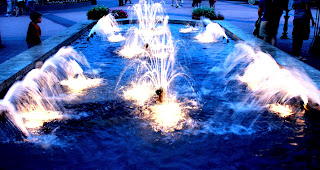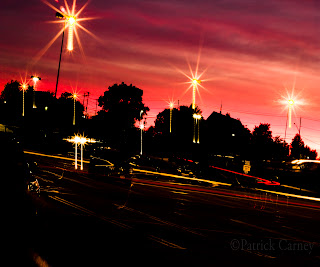Shutter speeds control the motion of an exposure. While apart of the holy trinity of taking a
picture with Aperture and ISO, shutter speed is what can freeze or blur an
image. My camera tops out at a shutter
speed of 1/4000th of a second. This is astronomically fast, but in
certain conditions, such as shooting in the middle of the day with an extremely
fast aperture like 1.4 a shutter speed this fast can be needed to control the
light in an image. Because direct sunlight
combined with a large aperture allows so much light to come into the sensor of
the camera it is important to limit how long the light has access. This is done
with the shutter speed.
The best way to see shutter speed in action is to use a
water source like a fountain or waterfall to demonstrate how shutter speed can
freeze motion.
In the top image you can see the water is
slightly blurred and creamy looking. In
the middle photo a shutter speed of 1/100th is used. This freezes
the water in place. In the final photo is a shutter speed of .3 seconds which
makes the water blur because of the movement.
Obviously your shutter speed is pretty reliant upon the type of lighting that you have. If you are in bright sunshine you have a alot of options for your shutter speed. You can go as fast or slow as you want. If you want a fast shutter speed to freeze action you can use a large aperture. If you want to use a slow shutter you would need to use a smaller aperture to counteract all the light coming in. Slow shutter speeds are great for capturing the movement of light. For instance, when shooting fireworks a slow shutter speed is beneficial because you can capture the entire streak of a firework instead of the burst in the moment. This can provide awesome streaks through the sky that not even the human eye can see.
Fast shutter speeds are preferable for use when shooting action and wanting to freeze that action. For instance, if you are at your childs soccer game and want to get some great shots of them, you don't want to settle for blurred images of them as they go running by. No you want them frozen in the moment. To do this you would use a fast shutter speed.
Fast shutter speeds are preferable for use when shooting action and wanting to freeze that action. For instance, if you are at your childs soccer game and want to get some great shots of them, you don't want to settle for blurred images of them as they go running by. No you want them frozen in the moment. To do this you would use a fast shutter speed.
Another side effect of shutter speed can be the need for a lens with image stabilization or not. The general rule of thumb is that whatever focal length you are shooting at is at least the shutter speed you want to be using. For instance when shooting with a 135mm length you would want to use a shutter speed above 1/135. If you were to use a slower shutter speed the odds are you would have some camera shake in the picture unless you have a lens with Image Stabilization or are using a tripod.





























